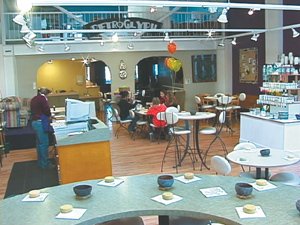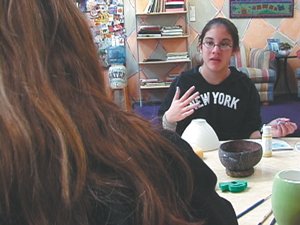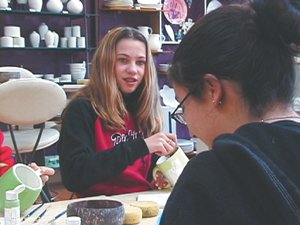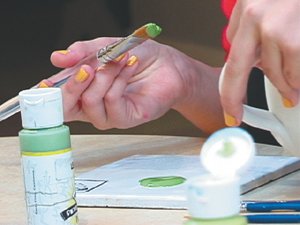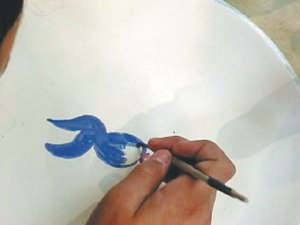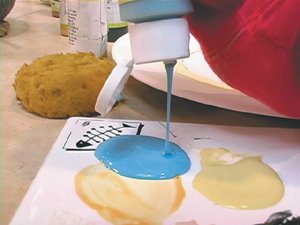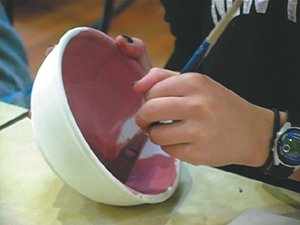Getting Coverage in Your Scene
| We touched on the relationships between shots in Lesson 7. There, you learned that each shot needs to have at least one other corresponding shot with which it has a natural dynamic. This section will outline the most important (and easiest-to-get) shots that create this dynamic. Christopher is not doing a documentary on ceramics or even on his daughter; he's just making a sketch of a moment in her life. The still photos were far better for getting bits and pieces of the whole event (arriving, painting, chatting, and eating cake). The video is intended to preserve a moment and make it interesting. The moment he chooses is the painting. Earlier in this lesson, you saw Christopher start the shoot by going to the edge of the room and shooting both a wide shot and a close-up from there. This is the first guideline for shooting: Get multiple shots from each position. Multiple Shots From Each PositionYou don't want to move around too much with your camera. You want to get the coverage you need from just a couple of fixed locationsmaybe two or three. If you're good, maybe four. But not ten. A common mistake is to shoot a little bit from here, wander around, shoot some more from over there, stop for a while, and then shoot from some new location. All of this will be more challenging to put together into a cohesive video. From whatever position you make your first shot, you want to get two shots. When Christopher made his first wide shot of the girls painting, he recorded for about 15 seconds and then stopped. Then he did the important thing: He zoomed in for a closer shot and recorded again, for 10 more seconds. If he was not in a hurry, he might have shot three shots from this location (a wide, a medium, and a close-up), but at least two are critical. Make two shots, then move to the next location. Shots and Reverse ShotsOnce Christopher got to his first position and recorded a couple of different shots from there, a question arises: Where to go next? The answer is easy. Once you've shot everything you can see from the first vantage point, move to the other side of your subject and shoot back toward where you were standing. In very general terms, you're moving about 180 degrees from where you started. The name for this is the reverse shot. Note Technically speaking, you're not going to move exactly 180 degrees opposite your original position. It's going to be closer to 120 degrees, but it's a detail that you can refine once you're in the habit of getting a reverse shot. When you are done shooting from the reverse position, you'll have two sets of shots (called, of course, shots and reverse shots), and those have a very specific dynamic between them. As long as the action is similar from both positions, these shot/reverse combinations can be cut together to give a remarkable experience to the viewersas if they were in two places at the same time. The shot/reverse dyad works wonderfully if a pair of people are talking or directly interacting. Focus on one of the two people for the first shot and on the second person for the reverse shot. Christopher's job was challenging because instead of two girls talking and painting, there were five. Still, by concentrating on two of them at a time, he was able to get the coverage he needed. Interaction between two people is almost always a compelling core to your videos. Everything else is just setting and ambience. The back-and-forth of human interplay is, in many ways, the precise reason you are using video and not still photography. Consequently, the shot/reverse shot is often the main element of your projects. You don't have to load up your camcorder and follow along with Christopher for this lessonprimarily because what he's doing won't precisely match what you're going to do in any given shooting situation. Hopefully, seeing his process will still be of value to you when you shoot your own projects. If you want to try these basic shooting guidelines, and you are encouraged to do so, set up a very basic scene. Two people sitting in chairs facing each other and playing a gametic-tac-toe, perhaps, or chess, or cards. Let the two "actors" play a real game, ignoring youand you shouldn't bother them. Shooting and getting this coverage will be straightforward and, while you won't use it for editing in Lesson 10, once you've finished that exercise, you could edit the material you just shot.
When you've finished shooting from these two positions, you have the core of your video coverage. With a shot and a reverse shot, you can build a compelling moment easily in iMovie. Tip Another specific shot used often in Hollywood is the over-the shoulder shot (usually shortened to OS shot). Instead of having a single shot of a person alone in the frame, keep the edge of the other person's back in the frame. This shows the physical relationship between themhow close they are to each otherand reminds the audience that two people are there, not just one. In conversations on film, particularly for medium shots, OS shots are the standard. The Cutaway ShotShots and reverse shots may make up the core of your video, but it's almost impossible to watch these two shots all day. What you need is something else to look at, a break. Behold the cutaway shot. It is a close-up of something other than the people in your video. It doesn't include anyone's mouth moving. Its sole purpose is to show you details and texture of what is going on. Any number of subjects can constitute a good cutaway shot. You'll probably find a half-dozen or more. You almost can't have too many, they're so useful. In some ways a good cutaway is almost a still photo: You frame some odd detail as a kind of still life. It doesn't have to be an image from the action (like hands painting), but instead could be anything that provides details within the environment (other people in the studio, odd bisque items on the shelves, the slideshow running on the big display at the bar, and so on). Don't shoot your cutaway shots until you're satisfied with your shot/reverse coverage. You can cheat the cutaways a little bit; they don't have to fit precisely with the shot/reverse and can often be shot very late in the event. You don't know how (or even if) you will use these shots while editing, but when you need one, you won't believe how important it is to have it. You'll end up picking one or twowhatever fits best with the video you're making. But those decisions will come later. For now, your job is to get all the coverage you might need. Here are some of Christopher's cutaway shots that he might use with the shot/reverse combinations you saw previously. Unlike the more standard shot/reverse combinations, cutaways beg for creativity. From any position (wide from across the room, from the side getting the shot/reverse), you've always got the opportunity to point the camera in a slightly different direction, zoom in, and get a cutaway shot. Remember that fewer shooting positions is generally better. Still, in some of the shots Christopher took, he set the camera down on the table or shot from high above his head, pointing the lens down at the table. The Establishing ShotFinally, you'll always need at least one establishing shot, which shows where this event is taking placea wide shot that depicts not only your main characters but also where they are situated. Sometimes this is the first shot you get; remember how Christopher started wide and far away before getting close for the shot/reverse? But don't be limited to a wide shot or a shot that includes the girls. The outside of the studio is perhaps a better establishing shot. Sometimes it's natural to get the establishing shot at the end, after the cutaways. Since the participation of the birthday girls isn't required, it's good to focus on them first and get the extra material afterward. It doesn't matter when you take the shot; just remember that establishing shots, particularly if they are wide, often need to play onscreen for a little longer than normal. Hold still (don't panit isn't necessary). If the venue or vista is too large for a single shot, stay in your position and point in a few different directions, changing from wide to closer as necessary. You can combine all these bits into a short establishing shot sequence. Tip Establishing shots can be exceptionally creative too. Don't just wander far away and shoot a big wide shot. Think about shooting from up high, over your head. Shoot through a windowreflections and all. Look for signage around that might help place you ("Welcome to Petroglyph Ceramic Lounge" or "Hot, Hot, Hot. Careful around kilns!"). The signs are good for establishing your location, but they don't need to be full frame, dead centerjust an edge of a sign or a snippet of a logo is often enough. |
EAN: 2147483647
Pages: 142
